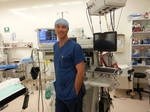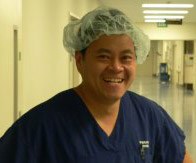Anaesthesia
The role of the Anaesthetist is to preserve and maintain the life of the patient during surgery and other procedures, and to supervise the patient during the recovery phase.
Responsibilities include pre-anaesthetic assessment of the patient, constant supervision of the patient during anaesthesia and management of pain following surgery. The Anaesthetist takes this role not only in relation to surgery in operating theatres but also for procedures in cardiac laboratories, endoscopy suites, imaging departments, labour wards and day surgery units. The role of the Anaesthetist as a peri-operative physician is expanding. Anaesthetists work closely with Surgeons, Obstetricians, Physicians and Radiologists and are usually supported by Anaesthetic Technicians.
Interviews

Dr Lance Nicholson
Dr Lance Nicholson works as an Anaesthetist at North Shore Hospital and explains about the specialty.
Dr Colin King
Dr Colin King is a Consultant in Anaesthesia at Auckland City Hospital. Click here to read about training in Anaesthesia in Auckland. ⇡ TopThere are currently 93 trainee posts across six hospitals, including Whangarei and Taranaki.
Sub Specialties
As well as general rotation posts in Anaesthesia and Intensive Care, experience can be gained in the following subspecialties:
- Pain
- Transplant Anaesthesia
- Paediatric Anaesthesia
- Obstetric Anaesthesia
- Cardiac Anaesthesia
- Regional Anaesthesia
- Burns
Fellowships are available but are arranged by the individual hospital departments.
⇡ TopSites and Resources
Hospital sites
- Whangarei Hospital
- Taranaki
- Auckland City Hospital
- North Shore Hospital
- Middlemore Hospital
- Australian and New Zealand College of Anaesthetists
How to train as an Anaesthetist
Training to become an Anaesthetist in Auckland is a comprehensive five year programme that encompasses all of the rotations required to fulfil the requirements of the Australian and New Zealand College of Anaesthetists. This involves rotations with any of the hospitals involved in the Auckland / Northern Regional Scheme, presently Taranaki, Whangarei, North Shore, Auckland City, Starship Children's, and Middlemore Hospitals.
The Auckland / Northern Regional Training Programme in Anaesthesia currently has approximately 93 posts in departments approved by the Australian and New Zealand College of Anaesthetists (ANZCA) for pre-Fellowship and Provisional Fellowship training. (In addition, a few posts exist in non-accredited departments, and so are not accredited by ANZCA for training, but in most respects are similar.) ANZCA accredits departments rather than a limited number of individual posts. Thus, if all the other requirements of training are satisfied, working in one of these departments will result in a trainee having that time accredited by ANZCA. As is inferred by the College's recognition of this scheme for the full five years of training, the experience gained covers all aspects of Anaesthesia, Intensive Care and Pain Medicine.
Within two years of the commencement of ANZCA accredited training (whether in the Auckland Regional Training Programme or elsewhere) all Registrars will be expected to have successfully passed the Primary FANZCA examination and the EMAC or acceptable equivalent course.
Within four years of the commencement of ANZCA accredited training (whether in the Auckland / Northern Regional Training Programme or elsewhere) all Registrars will be expected to have successfully completed the Final Fellowship examination and have completed the formal project.
For more information about training requirements of the Australian and New Zealand College of Anaesthetists, click here.
For the Unofficial Site of the Division of Anaesthesiology Faculty of Health and Medical Sciences, University of Auckland, click here.
For New Zealand specific information about teaching, training and research, click here.
⇡ TopCriteria
It is desirable for applicants to fit the following criteria:
- Current staff showing satisfactory progress
- Existing ANZCA trainees
- Those with previous Anaesthetic experience
- Applicants familiar with medical practice within the NZ Public Health Service
- Those currently holding general registration in New Zealand
Contacts
Who can I talk to and where to next?
The training programme in Auckland is organised by the Anaesthesia Vocational Training Committee with representation from all hospitals across Auckland. This Committee is committed to further improve the quality of teaching in Anaesthesia in Auckland.
Auckland City Hospital
mtennant@adhb.govt.nz
- Anaesthesia
- Emergency Medicine
- General Practitioners
- Intensive Care Medicine
- Medicine
- Obstetrics and Gynaecology
- Ophthalmology
- Oral Health
- Paediatric Medicine
- Palliative Medicine
- Pathology
- Psychiatry
- Public Health
- Radiology
- Radiation Oncology
- Rehabilitation Medicine
- Sexual Health
- Surgery and Surgical Specialities
- Dermatology
+64 9 631 0707
More contact details: Address RMO Recruitment Contacts
Postal Address
Health New Zealand | Te Whatu OraWorkforce Operations Northern
PO Box 112147,
Auckland 1642, New Zealand
Physical Address
Health New Zealand | Te Whatu OraWorkforce Operations Northern
James Fletcher House, Level 3
Connect Business Park
581-585 Great South Road
Penrose, Auckland 1061
